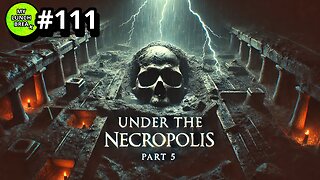Premium Only Content

Biography of 31 Caliph al-Muqtafi | المقطفی اکتیسویں خلیفہ کی سوانح عمری
@islamichistory813 #CaliphateHistory #AlMuqtafi #HistoricalBiography
Biography of al-Muqtafi 31th Caliph of Abbasid Caliphate.
Dekhti Aankhooon aur sountay kaanoon ko Asslamoalaikum, sisters, brothers friends and elders, In this islamic caliphs informative video, we present a comprehensive biography of al-Muqtafi, the 31st Caliph of the Abbasid Caliphate. we are describing the key events of his reign, his contributions to governance, and the socio-political challenges he faced. This exploration offers valuable insights into the dynamics of the Abbasid dynasty and its influence on Islamic civilization.
Abu Abdallah Muhammad ibn Ahmad al-Mustazhir better known by his regnal name al-Muqtafi li-Amr Allah was the Abbasid caliph in Baghdad from 1136 to 1160, succeeding his nephew al-Rashid, who had been forced to abdicate by the Seljuks. The continued disunion and contests between Seljuk Turks afforded al-Muqtafi opportunity of not only maintaining his authority in Baghdad, but also extending it throughout Iraq.
Birth and background
The future caliph al-Muqtafi was born on 9 April 1096 as Abu Abdallah Muhammad, the son of the Abbasid caliph al-Mustazhir .His mother was Ashin, a slave girl from Syria.[2] After his father's death his half-brother al-Mustarshid[2] succeeded him on 6 August 1118. Al-Mustarshid (r. 1118–1135)ruled for sixteen years as Caliph but the last three years of his reign were occupied with war against Seljuq sultan Mas'ud (his deputy). Not long after the siege of Damascus, al-Mustarshid launched a military campaign against Seljuk sultan Mas'ud, who had obtained the title in Baghdad in January 1133 by the caliph himself. The rival armies met near Hamadan. The caliph, deserted by his troops, was taken prisoner, and pardoned on the promising not to quit his palace. Left in the caliphal tent, however, in the sultan's absence, he was found murdered while reading the Quran, as is supposed, by an emissary of the Assassins, who had no love for the caliph. Modern historians have suspected that Mas'ud instigated the murder although the two most important historians of the period Ibn al-Athir and Ibn al-Jawzi did not speculate on this matter. Physically, al-Mustarshid was a red-haired man with blue eyes and freckles.
Al-Mustarshid was succeeded by his son and heir apparent, Al-Rashid Billah on 29 August 1135. Like his father al-Mustarshid, al-Rashid Billah made another attempt of military independence (forming his own military) from the Seljuks. To avenge his father's death, he insulted the envoy of sultan Ghiyath ad-Din Mas'ud who came to demand a heavy largess, incited the mob to plunder his palace, and then, supported by Zengi, who was equally hostile to the sultan because of the murder of Dubais ibn Sadaqah, set up a rival sultan. Mas'ud hastened to the rebellious capital and laid siege to it. Baghdad, well defended by the river and its canals, resisted the attack; but in the end the caliph and Zengi, hopeless of success, escaped to Mosul. The sultan's power restored, a council was held, the caliph deposed, and his uncle al-Muqtafi succeeded as the new caliph. Al-Rashid Bi'llah fled to Isfahan where he was assassinated by a team of four Nizari Ismailis (Assassins) in June 1138. This was celebrated in Alamut for a week.
So sisters brothers and friends tomorow we will be described Reign of al-Muqtafi 31th Caliph of Abbasid Caliphate. Allah Hafiz
===============================
-
 23:22
23:22
MYLUNCHBREAK CHANNEL PAGE
2 days agoUnder The Necropolis - Pt 5
210K71 -
 54:05
54:05
TheGetCanceledPodcast
1 day ago $14.91 earnedThe GCP Ep.11 | Smack White Talks Smack DVD Vs WorldStar, Battle Rap, Universal Hood Pass & More...
202K35 -
 8:30
8:30
Game On!
19 hours ago $0.91 earnedLakers BLOCKBUSTER trade! Luka Doncic is coming to LA!
32.3K4 -
 48:29
48:29
hickok45
23 hours agoSunday Shoot-a-Round # 266
30.7K10 -
 15:18
15:18
SternAmerican
3 days agoStern American with Sam Anthony from YourNews.com
21.3K1 -
 1:03:13
1:03:13
PMG
1 day ago $1.97 earnedRFK, Tulsi & Kash Hearings, the Plane Crash in the Potomic, & Ozempic
19.2K2 -
 11:33
11:33
DeVory Darkins
1 day ago $23.60 earnedJustin Trudeau PANICS after Trump slaps Canada with AGGRESSIVE Tariffs
120K265 -
 19:11
19:11
Stephen Gardner
1 day ago🔥HOLY CRAP! Chuck Schumer UNDER INVESTIGATION | 3 HUGE Trump MOVES explained!
130K338 -
 4:53:35
4:53:35
Rotella Games
21 hours agoGrand Theft America - GTA IV | Day 4
89K5 -
 10:33:02
10:33:02
Scottish Viking Gaming
18 hours ago💚Rumble :|: Sunday Funday :|: Rumble Fam Knows What's Up!!
58.9K5